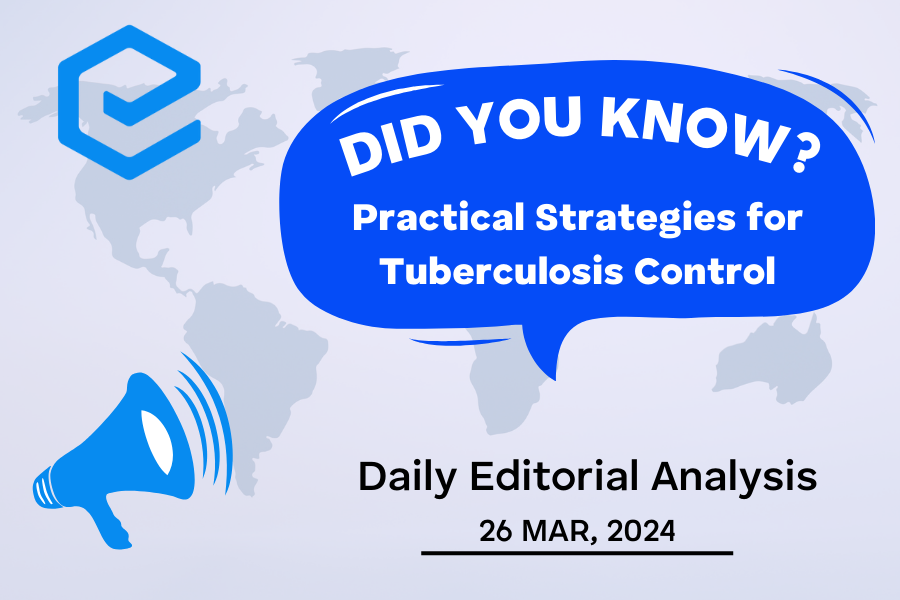
In addressing tuberculosis (TB) control, practical strategies are indispensable. The editorial underscores the importance of adopting multifaceted approaches tailored to diverse contexts. One significant aspect highlighted is the necessity of early detection through robust screening programs, particularly in high-risk populations. Integrating TB screening with existing healthcare infrastructure can enhance accessibility and efficiency. Additionally, the editorial emphasizes the importance of comprehensive treatment regimens, including directly observed therapy, to ensure patient adherence and minimize the risk of drug resistance. Moreover, community engagement and education initiatives play a pivotal role in dispelling misconceptions and fostering support networks for individuals undergoing treatment. Collaboration between healthcare professionals, policymakers, and community stakeholders is deemed essential for sustainable TB control efforts. By prioritizing these practical strategies, progress can be made towards mitigating the burden of TB and achieving global health objectives.
Tag: GS-2 Health
In News: World TB Day, observed on March 24, marks the anniversary of Dr. Robert Koch’s identification of Mycobacterium tuberculosis, the bacterium responsible for causing tuberculosis, in 1882.
Contents
- 1 Background
- 2 Key Points
- 3 India’s TB Situation
- 4 10-point Agenda Towards Ending TB
- 5 Conclusion
- 6 Frequently Asked Questions (FAQs)
- 6.1 FAQ 1: What are the key components of practical strategies for tuberculosis (TB) control?
- 6.2 FAQ 2: How can TB screening programs be effectively implemented in diverse settings?
- 6.3 FAQ 3: Why is community engagement crucial in TB control efforts?
- 6.4 FAQ 4: What role do comprehensive treatment regimens play in TB control?
- 6.5 FAQ 5: How can collaboration among healthcare professionals, policymakers, and community stakeholders enhance TB control efforts?
- 7 In case you still have your doubts, contact us on 9811333901.
Background
- Despite significant discoveries in the treatment of tuberculosis (TB) dating back to streptomycin in 1943 and subsequent antibiotics like isoniazid and rifampicin, the battle against this pathogen remains unresolved, facing numerous challenges.
Key Points
- The theme for World TB Day 2024, ‘Yes! We can end TB!’, highlights the potential to eradicate TB through existing disease control measures, infrastructure, training, and political commitment.
- However, various forms of TB, including drug-resistant strains, continue to pose significant challenges, akin to trying to contain sand slipping through one’s fingers.
- Each day, approximately 3,500 individuals worldwide lose their lives to TB, with around 30,000 new infections reported, India alone accounting for 27% of global cases.
India’s TB Situation
- India remains a hotspot for TB, despite ongoing efforts and adaptations in the TB control program since its inception in 1962, integrating evidence from various public health domains.
10-point Agenda Towards Ending TB
- Early Detection: Emphasizes the importance of prompt identification of TB symptoms and the necessity of compulsory screening for close contacts.
- Precise Treatment Categorization: Urges knowing the resistance status to tailor treatment regimens effectively.
- Treatment Adherence and Follow-up: Highlights the need for sustained treatment adherence and leveraging technology for monitoring compliance.
- Zero Mortality: Advocates for mitigating TB-related mortality across all forms of the disease.
- Controlling Drug Resistance: Addresses the man-made phenomenon of drug resistance and the need for better regulatory mechanisms.
- Assessing Drug-resistant TB Extent: Emphasizes the importance of data collection to inform control programs and resource allocation.
- Availability of Appropriate Medicines: Calls for addressing procurement challenges for DR-TB medications.
- Integration into Larger Health Systems: Stresses the need for strong referral networks to ensure comprehensive care.
- Dynamic Notification System: Calls for improvements in real-time TB data capture and sharing.
- Population Mobility and Migration: Highlights the importance of ensuring portability of TB treatment within the country.
Conclusion
- The journey towards TB elimination in India necessitates a unified focus on person-centered care, addressing social determinants of health, and embracing innovation.
Source: AIR
Frequently Asked Questions (FAQs)
FAQ 1: What are the key components of practical strategies for tuberculosis (TB) control?
Answer: Practical strategies for TB control typically encompass early detection through screening, comprehensive treatment regimens, community engagement, healthcare infrastructure integration, and collaboration among stakeholders.
FAQ 2: How can TB screening programs be effectively implemented in diverse settings?
Answer: TB screening programs can be effectively implemented by integrating them into existing healthcare infrastructure, targeting high-risk populations, utilizing rapid diagnostic tools, and ensuring accessibility to reach marginalized communities.
FAQ 3: Why is community engagement crucial in TB control efforts?
Answer: Community engagement is crucial as it helps dispel misconceptions about TB, encourages early detection and treatment-seeking behavior, provides support networks for patients, and fosters sustainable efforts towards TB control.
FAQ 4: What role do comprehensive treatment regimens play in TB control?
Answer: Comprehensive treatment regimens, including directly observed therapy (DOT), are vital for ensuring patient adherence, minimizing the risk of drug resistance, and achieving successful treatment outcomes in TB control programs.
FAQ 5: How can collaboration among healthcare professionals, policymakers, and community stakeholders enhance TB control efforts?
Answer: Collaboration among stakeholders facilitates the development of coordinated strategies, resource optimization, implementation of evidence-based interventions, and addressing systemic barriers, thereby bolstering TB control efforts at local, national, and global levels.
In case you still have your doubts, contact us on 9811333901.
For UPSC Prelims Resources, Click here
For Daily Updates and Study Material:
Join our Telegram Channel – Edukemy for IAS
- 1. Learn through Videos – here
- 2. Be Exam Ready by Practicing Daily MCQs – here
- 3. Daily Newsletter – Get all your Current Affairs Covered – here
- 4. Mains Answer Writing Practice – here

